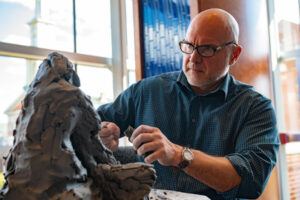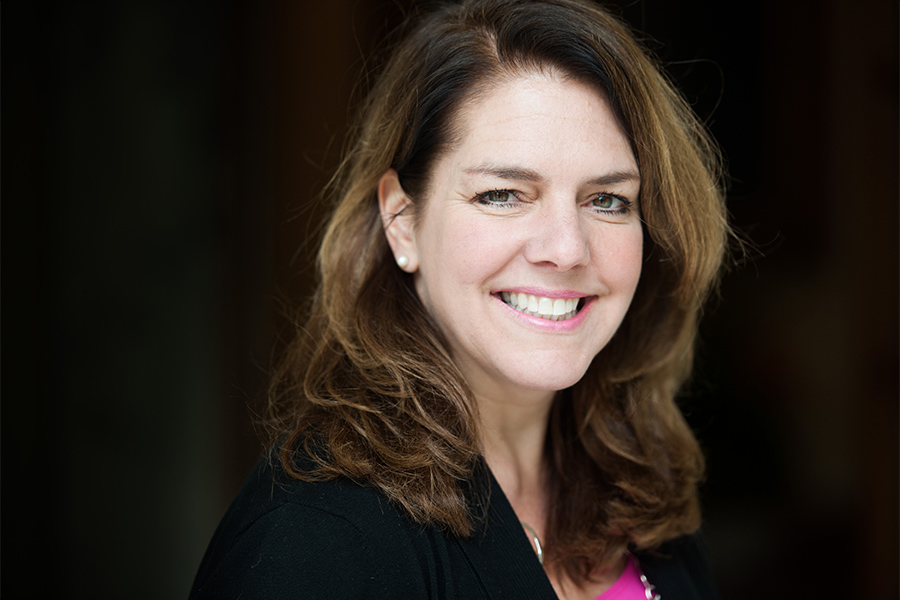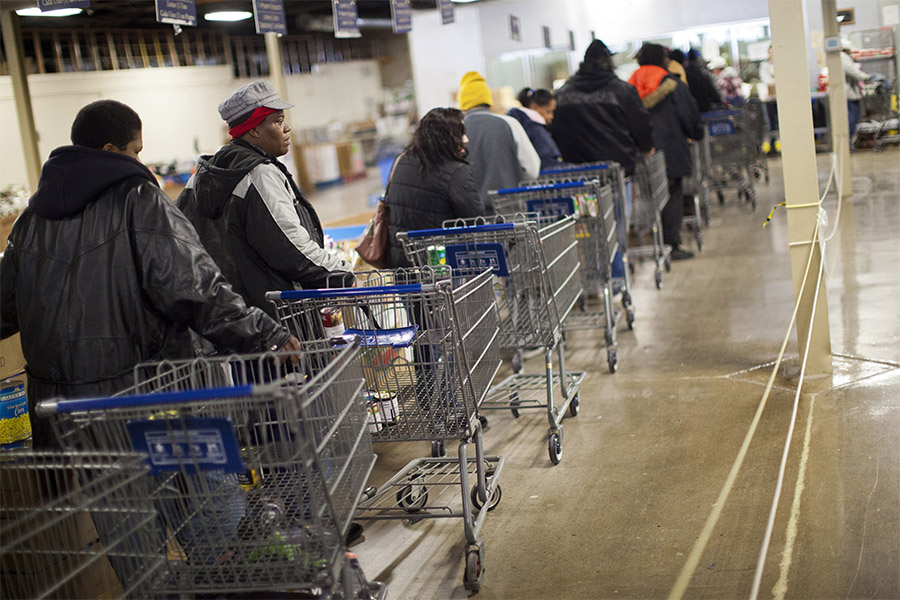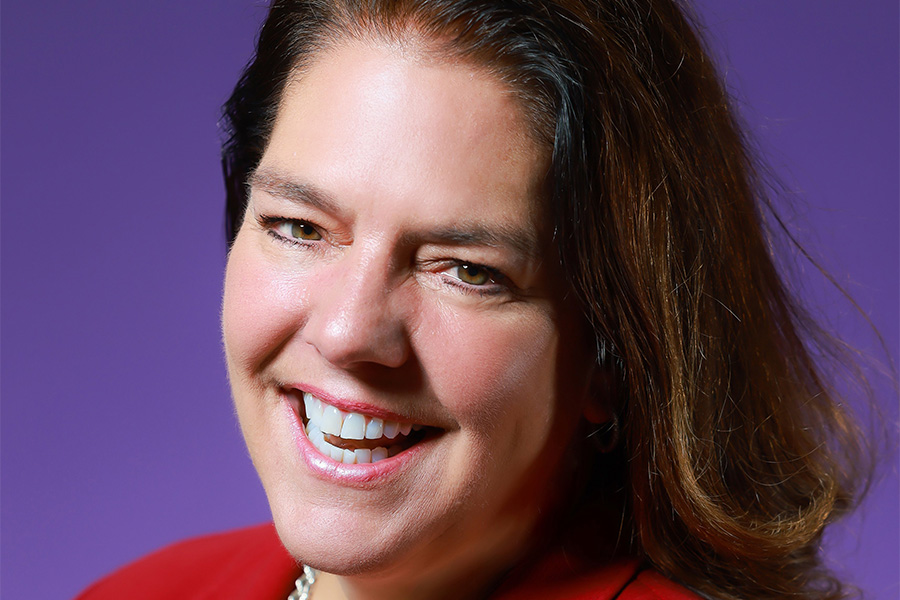Catholic Charities leaders from around the country could watch renowned Canadian sculptor Timothy Paul Schmalz create a new piece depicting Jesus embracing a homeless person as they held their 2022 Annual Gathering in Baltimore Sept. 27-29.
Among the other exhibits – pitching companies offering fundraising services, building supplies, bunk beds for shelters and shelf-stable milk for food pantries – Schmalz set up a stand-up-height table on which he built a maquette – a clay model – of what will eventually be a life-size bronze statue, copies of which will be made available exclusively to Catholic Charities agencies across the country.
William J. McCarthy Jr., executive director of Catholic Charities of Maryland, said his agency plans to have one of the statues. The agency already has one of Schmalz’ “Homeless Jesus” statues, at St. Vincent de Paul Parish, and “When I Was Hungry” at Our Daily Bread Employment Center.
The statues, McCarthy said, are “a visible manifestation of what we do.”

The gathering, built around the theme “Paths to Encounter,” featured plenary talks by Dominican Sister Donna Markham, CCUSA president; Schmalz; and Matthew Desmond, Pulitzer Prize-winning author of “Evicted,” which chronicled eight families in Milwaukee striving to keep a roof over their heads.
In her address, Sister Donna told the attendees that saying “yes” to a position of ministry is an affirmative response to God calling us closer. “We are saying ‘yes’ to love better, to care more deeply, and to suffer alongside those who need to share their stories with us.
“The path to encounter is a transformative one. It opens our souls and our hearts to glimpsing the very face of Jesus. It opens our hearts to love people whom we might never have met in a more ‘ordinary job.’”
She told the more than 500 registrants from 85 Catholic Charities agencies across the country who attended that she wished more people could see the ways that Catholic Charities agencies serve hundreds of thousands of people affected by natural disasters and human-caused problems.
“Whether it is trying to cope with the trauma of mass shootings; unexpected and massive migration; or the consequences of fires, hurricanes, tornadoes, and floods, you have stepped in to help and done so in a manner that has upheld the dignity of the people you are assisting, she said. “When lives have been shredded and there is literally nothing to sustain them, you have been there to offer help and solace.”

She said that because of these encounters, both the one serving and the one in need are affected.
“Each one of these encounters with someone who is hurting, someone whose journey has been difficult, someone who needs help, stretches the depths of our own mercy and compassion. Truly, this is a lifelong journey for all of us,” Sister Donna said.
During his talk, Schmalz explained some of his work process. Projecting photos of some of his works, he said he often focuses on themes of the poor, downtrodden or forgotten. The Vatican commissioned him to create a sculpture, “Angels Unawares,” that includes a boatload of migrants of all races and faiths. The title is a reference to the Hebrews 13:2, which says, “Do not neglect hospitality, for through it some have unknowingly entertained angels.” Pope Francis unveiled the sculpture in St. Peter’s Square in September 2019.
He is working on a sculpture about human trafficking, featuring St. Josephine Margaret Bakhita, who was kidnapped in Sudan in 1877 at the age of 7 or 8, and was bought and sold as a slave more than a dozen times over 12 years. She is the patron saint of human trafficking as an example of how a victim can recover from trauma and become whole again. The statue shows St. Bakhita releasing oppressed people from the underground.
As he worked at the Catholic Charities conference on the statue of Jesus embracing the person who is homeless, Schmalz told the Catholic Review he addresses poverty because “I don’t think you can really have enough representations, sculptures that show the value in the sacredness of human life.”
He said he works at his art for about eight hours a day, taking breaks every half hour to exercise and to pray. While sculpting, he plays a recording of the Bible nonstop. “It’s part of my ritual, in a sense, as a Catholic sculptor, to be saturated with Scripture and the lives of the saints and to have it always on the top of my mind,” Schmalz said.
For a great piece of artwork or sculpture, “you first need not clay, not bronze, but an epic idea,” he said. “That is what Christianity, Catholicism specifically, provides me, and it’s the eternal truths that are expressed in the saints or in the Scripture that fuels me to do the best I can to get this out there.”
Regarding the piece he created at the conference, he said, “Ideally, people will not even see the artwork. When they see this sculpture, they will see the message of love and compassion that Christ has for us all, for the least in our community.”
He said that due to typical depictions of Christ in art over the last decades and even centuries, most people – including those living on the street – would have a vision of Jesus as a white person, “with perfect teeth … far away from them visually.” To bring Jesus down to the street with those who are suffering shows love and respect.

“A sculpture like the ‘Homeless Jesus,’ where Jesus, in fact, is a homeless person, or if there is Jesus embracing a homeless person, (that person) is going to regain – artistically anyway – that idea symbolically, that he has every human worth and is sacred,” Schmalz said.
There are eternal truths found in the Gospel and yet, every Sunday, priests around the world are “crafting new homilies of the eternal truths,” he said. In a similar way, his work is like “a frozen homily that will be there when it’s finally done, forever” when it is cast in bronze.
“I think that there’s hunger out there to see new representations of Jesus that have him actually coming out of the church, on the corner of the street, and in a sense, preaching there,” the artist said.
“This sculpture might resonate with one homeless person in a way that I can’t even imagine right now. And that’s the beauty of artwork,” he said.
Archbishop William E. Lori celebrated the opening Mass for the gathering at the Basilica of the National Shrine of the Assumption of the Blessed Virgin Mary.
As part of the conference, about 50 people had a chance to visit several local Catholic Charities sites in Baltimore. McCarthy, who accompanied the group, noted that it was a chance to share with colleagues the work being done by the Maryland agency, which is the third largest in the country, and will celebrate its 100th anniversary in 2023.
The visit included a stop at Our Daily Bread Employment Center downtown, where attendees helped serve a meal to the center’s clients. ODB has not missed a day of serving a hot meal to guests in more than 41 years – even through inclement weather and the pandemic – more than 14,600 consecutive days.
The group also visited Basilica Place, the agency’s first senior housing apartment building, and Cherry Hill Town Center, a multi-purpose campus that includes housing as well as a library, a bank, pharmacy, community market and even a barber shop.
The tour also included a few other of the agency’s 20 sites that serve more than 80 programs. “What I wanted to show our colleagues around the country is that any community development needs to be intentional. Housing without these other investments is not as significant or impactful,” McCarthy said. Such projects can be a catalyst for other investment and development.
Some of those on the tour noted that their agencies are not as large as Baltimore’s, and cannot do as much. He emphasized that Catholic Charities always have a role to play as they think about how to make the biggest difference. “We weren’t always this big,” he said. “You cannot do it all alone – you have to work with community partners and be open to possibilities.”
The motto for Catholic Charities of Baltimore is “Cherishing the Divine Within,” and a sign attesting to that is at the entrance of every service site. “They saw the sign and how guests and clients were greeted. They saw that throughout,” he said of the singular purpose that imbues his agency.
It’s a sentiment that was echoed in the talks by Sister Donna, the CCUSA president, and Schmalz, the artist.
Email Chris Gunty at editor@CatholicReview.org
Read More Catholic Charities
Copyright © 2022 Catholic Review Media







